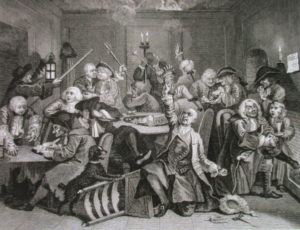EVENTS IN EARLIER YEARS (to give an idea of our scope)
Wednesday 16/5/18: Grand Order of Water Rats Museum – visit
Wednesday 27/6/18: Gliding at Kenley Airfield
Wednesday 25/7/18: The Charterhouse
Wednesday 26/9/18: Guided tour of Dulwich College
Wednesday 5/12/18: Mail Rail and the 2 Royal Mail Museums, Mount Pleasant.
Monday 29/1/19: Guided tour of the Watermen’s Hall.
Wednesday 27/3/19: Fuller’s Brewery Chiswick – Tour and tasting
Wednesday 26/6/19: RNLI Tower Station
Wednesday 31/7/19: Kia Oval Cricket Ground
Wednesday 25/9/19: Organ Recital – Brasted Church, Kent
Wednesday 30/10/19: Guided tour – Royal Courts of Justice
Wednesday 26/2/20: Hogarth’s House, Chiswick
Wednesday 15/9/21: Rail trip to Walthamstow
Wednesday 3/11/21: Rail trip to Dover
Wednesday 23/2/22: Visit to Walthamstow Wetlands
Monday 25/4/22: Walk from Downe
Wednesday 27/4/22: Rail trip to Portsmouth
Thursday 9/6/22: Exploring the Elizabeth Line
Wednesday 29/6/22: London from a Thames Clipper
POST COVID LOCKDOWN
Rail Trip to WALTHAMSTOW
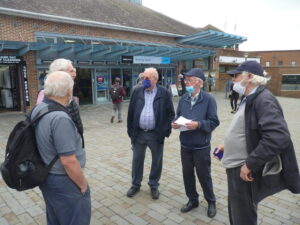
Led by Chairman Chris, a group of six of us met at Bromley South and caught the 9:34 to Victoria where we linked up with two more friends, who had started out from Orpington. We made our way to The Tube and proceeded to Walthamstow Central, arriving around 10:30. The weather was fine, warm and sunny.
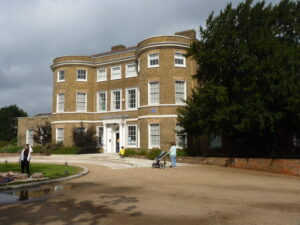
A short walk and we reached at the William Morris Gallery, a beautiful 19th Century house with its cafeteria overlooking a lovely park, Lloyd Park. The gallery houses a fine collection of drawings, paintings, tapestries, 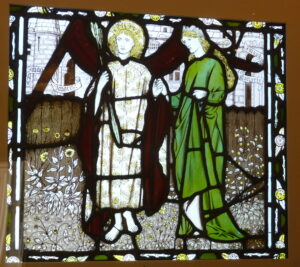 stained glass, printed fabrics and wallpapers. Printing on paper and fabrics required hand carved wood blocks and there was an impressive collection of these. The gallery has a gift shop devoted to products mainly based on Morris designs.
stained glass, printed fabrics and wallpapers. Printing on paper and fabrics required hand carved wood blocks and there was an impressive collection of these. The gallery has a gift shop devoted to products mainly based on Morris designs.
The movement of which William Morris was the leading figure, is known as Arts and Crafts and is of the late period of the Pre-raphaelite Brotherhood, a number of whose famous members were counted among Morris’s friends. Many of his designs incorporate natural subjects, birds, small animals, flowers and plants and the arrangements used for textiles and wallpaper designs and are influenced by Indian and Islamic art. Certainly it’s popularity endures to the present day.
We then set off for lunch at The Bell, along the road, only to find that COVID had  forced them to close during the day, so we returned to the Gallery cafeteria for a light lunch.
forced them to close during the day, so we returned to the Gallery cafeteria for a light lunch.
Refreshed, we felt able to face the 15 minute walk, past The Bell to Waltham Forest Town Hall and Assembly Rooms. The foundation stone for this imposing Art Deco  building was laid before the War, in 1938, but it was not completed until 1942. Originally a large round pond was set in front of the building but in the last few years this has been replaced with decorative dancing fountains, each ringed with coloured lights. This impressive display was switched on for our benefit.
building was laid before the War, in 1938, but it was not completed until 1942. Originally a large round pond was set in front of the building but in the last few years this has been replaced with decorative dancing fountains, each ringed with coloured lights. This impressive display was switched on for our benefit.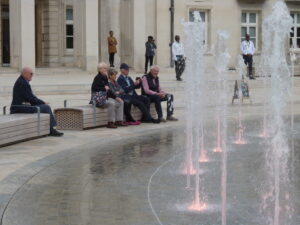
After an informative chat with a helpful official guide we returned to the Underground station and retraced our steps to our homes, feeling that we had enjoyed a memorable and satisfying day out.
Rail trip by Javelin Train to Dover.
Bromley South – St Pancras – Dover. Our train was a Javelin Train, impressively fast. 
At Dover we strolled in the town, looked at the harbour, 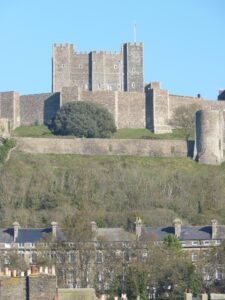 climbed to the clifftop on Dame Vera Lynn Way and admired the impressive views of Dover Castle.
climbed to the clifftop on Dame Vera Lynn Way and admired the impressive views of Dover Castle.
Walthamstow Wetlands
Outside the urban area are wetlands – low lying area of lakes and streams. These have been designated a Nature Reserve of London Wildlife Trust. The Reserve incorporates no less than five reservoirs and can be walked around on well maintained pathways. Our visitors were impressed by the range of water bird species.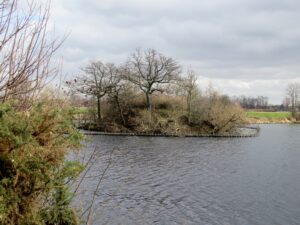
Walk from Downe.
On April 25th 2022, a small group set out from the centre of Downe, walking generally level footpaths among the meadows and bluebell woods nearby. After about 2 miles the group settled in the Queen’s Head, were joined by other members and enjoyed a refreshing drink and lunch.
Rail trip to Portsmouth
Just 2 days later Several members met at 09:14 at Waterloo for a rail trip to Portsmouth. Once there they visited the Dockyard and even took a boat tour. This brought them close to many and various vessels including two enormous aircraft carriers.
Exploring the Elizabeth Line (formerly Crossrail)
Bromley South – Charing Cross – Paddington and on to the new line. Immediately we were struck by the spaciousness of the station and the security of a glazed barrier at the platform edge. Sliding doors in this corresponded with those of the 10-car train. on towards Abbey Wood but we alighted at another huge station, Woolwich. 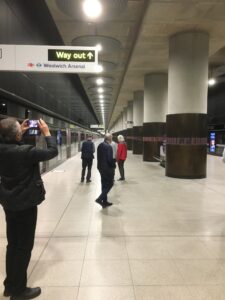
A short walk to the former Arsenal munition site which is now an attractive public open space.
A w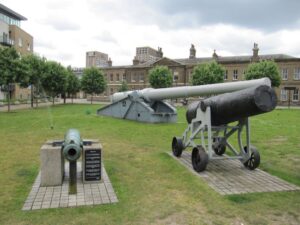 ide avenue took us to the riverside with lawns either side decorated with old cannons and naval guns to remind us of the history. A little to one side is a piazza in which sixteen identical, upright figures are standing, each comprising two iron castings bolted together.
ide avenue took us to the riverside with lawns either side decorated with old cannons and naval guns to remind us of the history. A little to one side is a piazza in which sixteen identical, upright figures are standing, each comprising two iron castings bolted together.
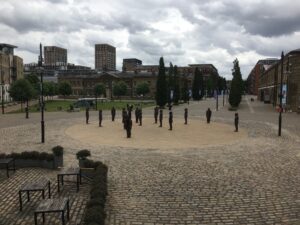
From Woolwich we journeyed to Canary Wharf. The station is below a shopping mall above which is a splendid roof garden. Associated with the Eden Project, this beautifully maintained site has avenues and beds in which a wonderful collection of exotic plants and trees are growing. 
From Canary Wharf we travelled to Battersea Power Station, Now being converted into flats and surrounded by tall buildings. There we took lunch before returning home.
London from a Thames Clipper
A train to London Bridge and a short walk to the eponymous pier. There we embarked on a Uber Boats Thames Clipper, a 220 seat catamaran. We set off towards Putney and very soon arrived there where the Clipper u-turned and started the return journey. We disembarked at Battersea Power Station. There we had a well earned cup of coffee at
on a Uber Boats Thames Clipper, a 220 seat catamaran. We set off towards Putney and very soon arrived there where the Clipper u-turned and started the return journey. We disembarked at Battersea Power Station. There we had a well earned cup of coffee at 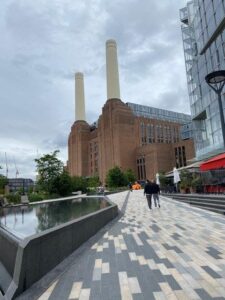 Megans. The Power Station is now dwarfed by surrounding high-rise blocks of flats and offices and is, itself being converted into flats and a shopping mall.
Megans. The Power Station is now dwarfed by surrounding high-rise blocks of flats and offices and is, itself being converted into flats and a shopping mall.
Refreshed we boarded another Clipper and sailed past the many familiar Thamesside sites to Greenwich.
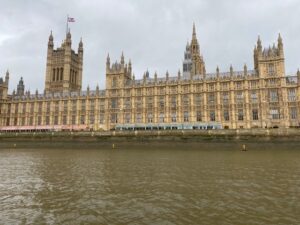
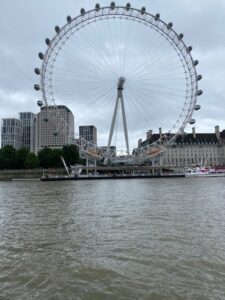
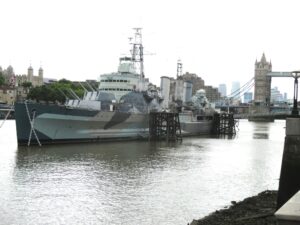 Strangely, from this new viewpoint the views looked somehow different.
Strangely, from this new viewpoint the views looked somehow different.
At Greenwich we sought the Old Brewery where we had a traditional lunch. After a wander round we split up, some taking a Clipper to North Greenwich and the Thames crossing cable car, while others returned to London Bridge an home. The Clipper service stops at the many piers along its route on both banks and the service comes every 20 minutes.
OLDER VISITS – KEPT TO ILLUSTRATE THE SCOPE OF CLUB VISITS
The Grand Order of Water Rats Museum
Following a good pub lunch at the inn of the same name, we entered a side door and were led to a conference room where our host introduced a jovial former Prince Rat who told us of the organisation’s history. He went on to mention many well known names of the entertainment world who support the organisation as well as describing its charitable activities. Then to the museum with so many artefacts ranging from Tommy Handley’s violin, Max Mille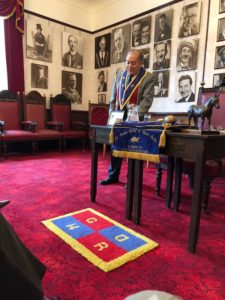 r’s loud check suit and Tommy Cooper’s fez with much more besides. Then back to a coffee room for a video and refreshments. a thoroughly good day.
r’s loud check suit and Tommy Cooper’s fez with much more besides. Then back to a coffee room for a video and refreshments. a thoroughly good day.
Gliding at Kenley Airfield
A beautiful sunny Summer’s day and a group of members of the Surrey Hills Gliding Club welcomed our group of nine to Surrey’s Kenley Airfield. With several pilots and two Grob gliders at our disposal we looked forward to an afternoon of unaccustomed experiences.
Each flight was launched into the air by a winch-driven cable and as the thermals were located and taken advantage of we banked and soared over Coulsdon, Whyteleafe and Caterham. Visibility was excellent and we could see Heathrow, The O2 Dome, Gatwick and all points between. A truly exhilerating experience.
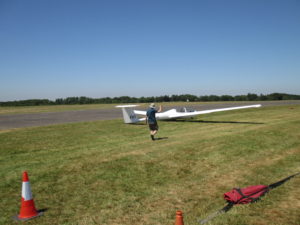
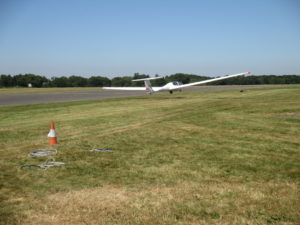
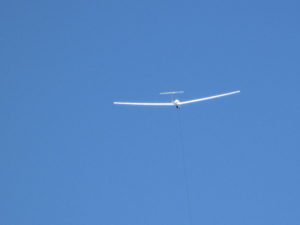
Up…………………………………Up…………………………and….Away !!!
A guided tour of The Charterhouse
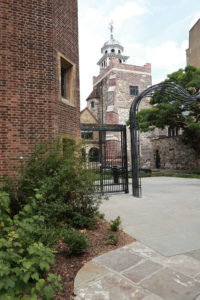 The story goes back a long way – to 1348 in fact. The original monastery was built on land outside the City walls, used to bury victims of the black death. With the dissolution of the monasteries, a mansion was built on the site, owned by a philanthropist, Thomas Sutton, who built alms houses and school that was to become the famous Public School. The school is no longer on the site, having moved
The story goes back a long way – to 1348 in fact. The original monastery was built on land outside the City walls, used to bury victims of the black death. With the dissolution of the monasteries, a mansion was built on the site, owned by a philanthropist, Thomas Sutton, who built alms houses and school that was to become the famous Public School. The school is no longer on the site, having moved 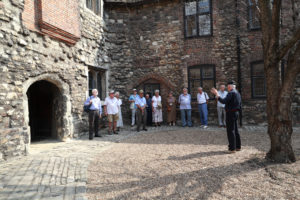 to Godalming in Surrey, in 1872. Old boys, known as ‘Old Carthusians’ include Thackeray and Baden Powell who inter alia are commemorated by wall plaques.
to Godalming in Surrey, in 1872. Old boys, known as ‘Old Carthusians’ include Thackeray and Baden Powell who inter alia are commemorated by wall plaques.
Our tour included the Chapel with Thomas Sutton’s monument, the Entrance Hall, the Library and the Great Hall. We were also shown the Great Chamber, visited by Queen Elizabeth the First and many other notable persons.
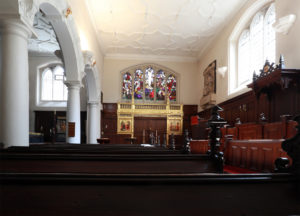
A guided visit to Dulwich College
The founder of the College was Edward Alleyn, a famous actor/manager, for whom Christopher Marlowe wrote his leading roles. Edward Alleyn derived most of his wealth from places of entertainment and Bear Gardens. He purchased the 70 acre manorial estate of Dulwich for £35,000 in 1613. It was then he conceived the idea of setting up a college or hospital for poor people and the education of poor boys. This charity originally consisted of a Master Warden, four Fellows, six Poor Brothers, six Poor Sisters and twelve Poor Scholars (orphans were admitted from the age of six years). His original buildings survive adjacent to the College Chapel in the middle of Dulwich Village.
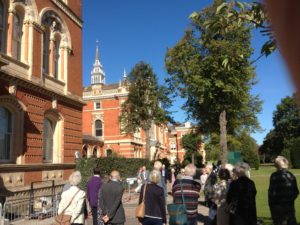
Our guide, the College Archivist, first invited us to view the main building, completed in 1866. The architect was Charles Barry Junior (the son of Charles Barry the architect responsible for the Palace of Westminster and many other prominent  buildings).
buildings).
We were shown the relatively new science block where the restored James Caird, the sailing lifeboat used by Sir Ernest Shackleton (who led three polar expeditions to Antarctica). This lifeboat, in an epic voyage to South Georgia, saved Shackleton’s life and those of his expeditionary crew following the loss of his ship, the Endurance, which was crushed by Polar ice.
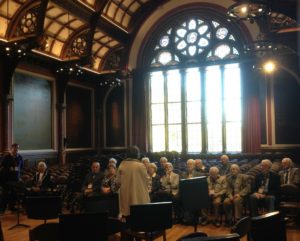
Our guide took us to the Great Hall and finally to the Archives room where there were many interesting items, including a copy of the original Letters Patent, press cuttings, and the variety of uniforms and caps and blazers for scholars, boarders and sports team members.
Royal Mail Museums and ‘Mailrail’.
The museum gave a well illustrated history of our mail service from its early beginnings in the reign of Henry VIII, the development of mail coaches in the late 1700s and postage stamps in the 19th century. Its progress in distributing mail is symbolised by a collection of road

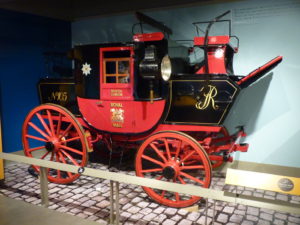 vehicles and the dedicated narrow gauge underground railway with loading and unloading stations under much of central London. These days the ‘Mail Rail’ is no longer used for its original purpose but provides visitors with an interesting ride with projected film history at each station stop.
vehicles and the dedicated narrow gauge underground railway with loading and unloading stations under much of central London. These days the ‘Mail Rail’ is no longer used for its original purpose but provides visitors with an interesting ride with projected film history at each station stop.
 The museums also illustrate the introduction of mail trains, telegrams and the telephone with examples of each phase including switchboards. Also referred to is the Post Office link with short wave radio communication and its leading to Radar. All in all, a great trip.
The museums also illustrate the introduction of mail trains, telegrams and the telephone with examples of each phase including switchboards. Also referred to is the Post Office link with short wave radio communication and its leading to Radar. All in all, a great trip.
Watermen’s Hall
Almost all the riverboat operational personnel belong to the Company of Watermen and Lightermen, founded in 1514. Their headquarters is a fine Georgian building situated in St. Mary at Hill in the City of London, not a stone’s throw from The Monument. The Company assists in the training of apprentices whom are eligible to compete in what is believed to be the oldest continuously held race in the World – a rowing race which was first raced in 1715. The prize is the right to wear Doggett’s Coat and Badge. The coat is a scarlet frock coat designed in the 18th century and the badge is a decorated silver badge worn on the upper left arm.
Fuller’s Brewery, Chiswick
After a good pub lunch at the Mawson Arms, at 2pm we met Guide, Dave, a former maths teacher who took us round the extensive premises. Fuller’s claim to be the oldest UK brewery still in production, having been founded in 1654 ad. We sampled differently roasted barley grains and were told of the way in which tapwater is de-chlorinated and mineralised with gypsum to provide the optimum flavour. We saw the huge mash tuns in which the barley is steeped in hot water to make ‘wort’ which with the addition of hops and yeast is fermented until it becomes beer. The yeast grows in quantity during fermentation and is later separate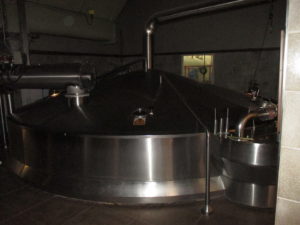 d, being transferred to a factory elsewhere to become Marmite. After separation of the wort, residual grains are shipped out to farms as cattle feed. Nothing is wasted.
d, being transferred to a factory elsewhere to become Marmite. After separation of the wort, residual grains are shipped out to farms as cattle feed. Nothing is wasted.
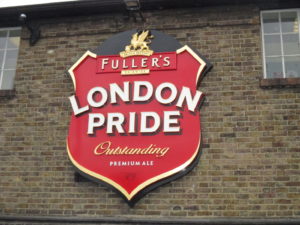
By far the largest volume of beer made at the brewery is ‘London Pride’ a premium draft beer. This is transferred to stainless kegs which a robot transfers to and from conveyor belts for loading on the road distribution vehicles. The remainder of the production is in the form of several bottled beers, IPAs, Porters and several other specialities. The tour ended in a sampling room where the different beers could be sampled and their tastes compared. A great day out!!!
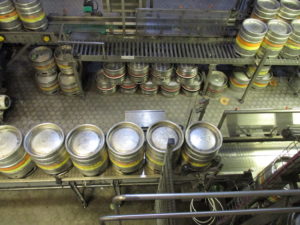
RNLI Tower Lifeboat Station

Volunteer, Jill introduced our party of 17 to the work of the busiest station in the UK and Ireland. She described the work they undertake , types of events requiring ‘a shout’, the equipment and boats at their disposal and she then went on to introduce us to Nick. Also a volunteer, Nick showed us the lifeboatman’s clothing, safety devices and he went into the details of the 50mph rigid hull, water jet propelled rescue boat, its communications, radar and life saving facilities. A two hour afternoon flew by and all agreed that we had had a most interesting visit.
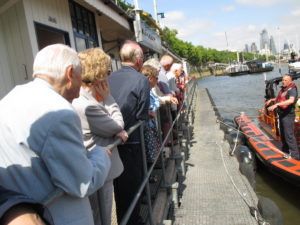
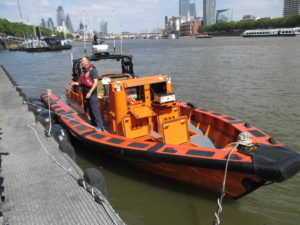
The Kia Oval Cricket Ground
Sunshine greeted us and our guides Chris and Peter on the 31st of July. We were given a very interesting introduction to the Ground’s history. From market garden to cricket field for local clubs and then to the home of Surrey County Cricket Club. Not widely known but the land is owned by the Duchy of Cornwall. We toured the huge pavilion,with its ‘Long Room’, a museum of bats, balls, protective clothing and signatures of cricketers from all nations. Then to the huge new stand with its roof terrace and wonderful views of the ground and much of the London skyline. Altogether a wonderful 2-hour visit.
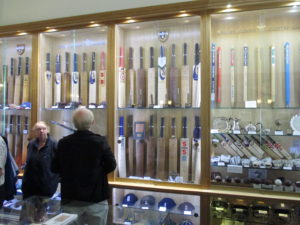
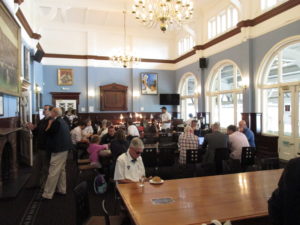


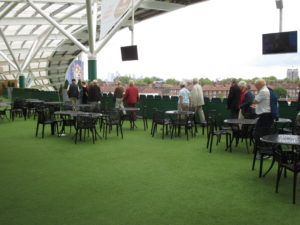
Organ Recital, Brasted Church
Our Past Chairman and his Wife welcomed a sizeable turnout to this historic church in the attractive Kentish countryside with coffee and biscuits.
They went on to present us with a carefully chosen repertoire of organ music which also included two pieces in which they accompanied a trumpet soloist. Although of Norman origin, the church has bee rebuilt twice in the 20th century, once due to a nearby V2 rocket and in 1987, a dreadful fire. Following the latter, a new organ was installed and the sound in that beautiful church was really lovely. Following the performances we repaired to ‘the pub next door’ for a most pleasant lunch. 
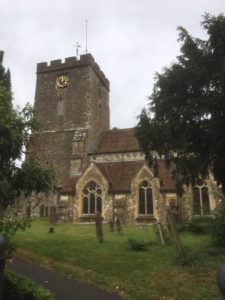
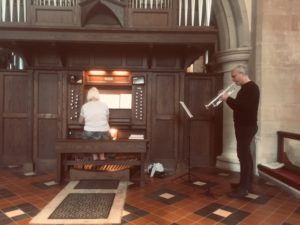
Royal Courts of Justice
A glorious Autumn morning greeted 27 members of the Club who assembled in The Strand outside the cathedral-like buildings of The Royal Courts of Justice. We were split into two groups, each with a well informed and highly informative guide. The Courts are used to settle Civil legal disputes, criminal cases being judged at The Old Bailey.
Our guides described the history and building of the Courts and the facilities provided for judges and for barristers and their staffs. We were taken into one Court and the organisation of a trial described. All-in-all it proved to be a most interesting visit.
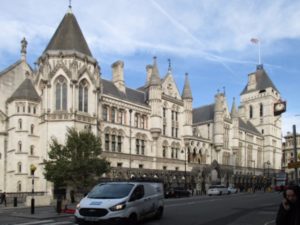
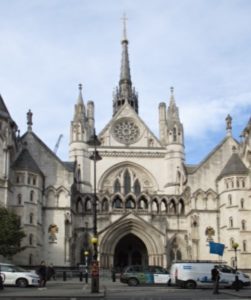
Hogarth’s House, Chiswick
This small, late 17th century house is a museum of Hogarth’s life. It houses his clothing and footware, the tools of his brilliant trade as an engraver and prints of much of his body of work. His subjects are the ills of society, drunkenness, gambling and prostitution and the degradation they produced. Among his friends was Thomas Coram of Islington, who founded the Foundlings Hospital for the care of abandoned children.

